Current Issue  Fish Profile
Fish Profile
 Fish Profile
Fish Profile
Fish Profile
Hoeven's wrasse or Melanurus wrasse, Halichoeres melanurus |
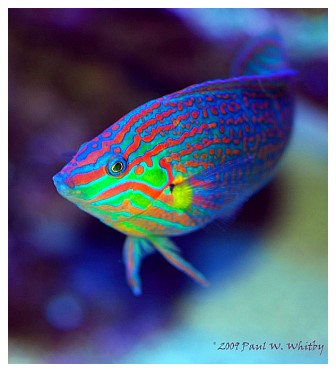 |
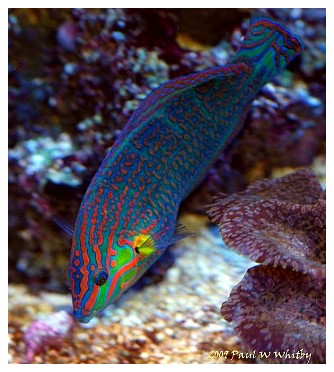 |
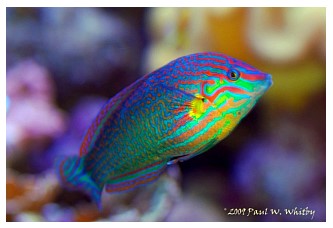 |
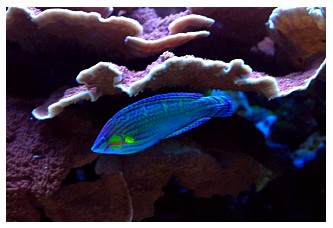 |
Photos courtesy of Paul Whitby and Edward Brookshire.
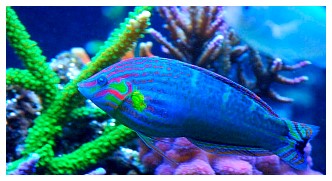 |
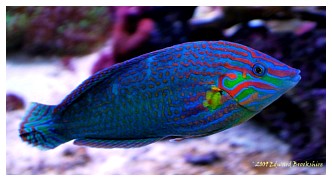 |
| Common Name: | Hoeven's Wrasse, Melanurus wrasse, Tail-spot Wrasse, Orange-tipped Rainbowfish, Pinstripe wrasse. Often misidentified as a Christmas, Pink Face or Ornate Wrasse. Orignally described in 1851 by Bleeker, who called it by the less-used name of Duskytailed rainbowfish and gave it the scientific name H. hoevenii. |
| Scientific Name: | Halichoeres melanurus |
| Size: | Approximately 6" as an adult. Juveniles are regularly seen in the trade at 1.5 to 2". |
| Distinguishing Features: | An elongated torpedo-shaped body with red lines originating at its mouth and extending to the base of its tail. The juvenile's colors are a pale blue body color with feint red stripes. As an adult, their colors become more vibrant. The face of the fish has a yellow or green background which blends to a blue hue beyond the gills. The horizontal stripes become brighter, but more irregular and splotched. The adult body has a series of vertical blue "stripes" that extend from the dorsal fin and appear to 'break" the red lines. The tail is blue with a characteristic spot, although I have seen some specimens that do not have this spot. |
| Distribution: | Western Pacific - extending from Japan and south to the Great Barrier Reef, east to Samoa and Tonga. |
| Natural Habitat: | Predominantly reef associated where it feeds upon its natural diet of small fish, crustaceans, motile invertebrates and worms. The social structure is that of a harem; a single large male will monopolize a harem of smaller females. Interestingly, if the male is lost, the largest female will assume the attitude and role of the male and mock spawn with the other smaller females - usually within the first hour. Over the next month the dominant female will carry on the actions of the male, engaging in apparent spawnings until such time as it becomes a male and begins producing sperm. (Sakai et al, 2002). |
| Feeding Requirements: | Melanurus wrasses will eat the vast majority of prepared foods, including flakes and pellet foods. They readily accept Mysis, brine shrimp and mixed-blend frozen foods. In fact, in my personal experience it would be hard to say what this wrasse will not eat. Due to its vast appetite, this wrasse is often included in marine systems as a functional predator of parasites, including flatworms (most notably the red planaria type), as well as pyramid snails that may infest clams. Smaller specimens are excellent for reducing numbers of Montipora-eating nudibranchs as their small stature allows them easy access to scrolling corals. The flip side of this is that they are voracious eaters and will consume a great deal of the available food before the more timid fish in the tank have a chance to eat their fill. |
| Difficulty Rating: (1 = easy - 5 = hard) |
This fish is easy to keep in an otherwise healthy system. Melanurus wrasses do have a tendency to hunt for snacks, which will lead to a few small pebble-sized rocks being moved about the aquarium. This is a slight issue, though. The main caveat with this fish is the fact that it grows fast and can rapidly achieve 6" in length. As the fish matures, its colors become more vibrant. My experience leads me to a rating of "2." |
| Aggressiveness Rating: (1 = shy - 5 = nasty) |
I rate this fish a "2." While it is not overtly aggressive, it will intimidate smaller fish from obtaining food when feeding. The only aggression I have seen is towards its own species. |
| Captive Requirements: | Like all of the Halichoeres species this wrasse requires a sand bed in which to sleep. Ideally, a soft sand in the sugar-grain size at about 2-3 inches depth will provide a suitable bed. Coarser substrates should be avoided so as not to stress the Melanurus wrasse. |
| Reef Tank Compatibility: | Safe in a reef environment, and in light of its feeding habit, I would strongly recommend this, or any of the available Halichoeres species, as a biological control of nuisance nudibranchs, flatworms and pyramid snails. I would not recommend this fish in tanks smaller than 55 gallons. |
| Personal Experience: | I have owned quite a few of these gorgeous fish over the years. When recently setting up a large tank (600g) I added four juvenile fish. For the first few days they would fight constantly, though damage to the fish itself was minimal. However, after that they have all lived in peace. Due to the rapid growth of this fish - expect a 2" specimen to reach 6" inside three years - I removed two from the tank and passed them to fellow hobbyists. This fish is constantly on the move and is always hunting tasty snacks such as pods in the tank. They are constantly scrutinizing the rock until something is spotted at which time they will hover and then peck... before moving on. Due to its striking coloration, this fish really stands out in the tank and is usually one of the first fish visitors notice. |
| Further Reading: | Wrasses and Parrotfish by Scott W Michael |
Note: All of the above information has been compiled from various sources and should be used as a guideline, not a hardfast rule. Use caution when selecting animals for your own tank and research as much as possible before purchasing any animals. Remember that certain corals and fish are very hard to keep if their special requirements are not met. The information contained here is to help you make an informed decision. The author assumes no responsibility for any consequences that may arise from the use of this information.
If you have any questions about this article, please visit my author forum on Reef Central.


